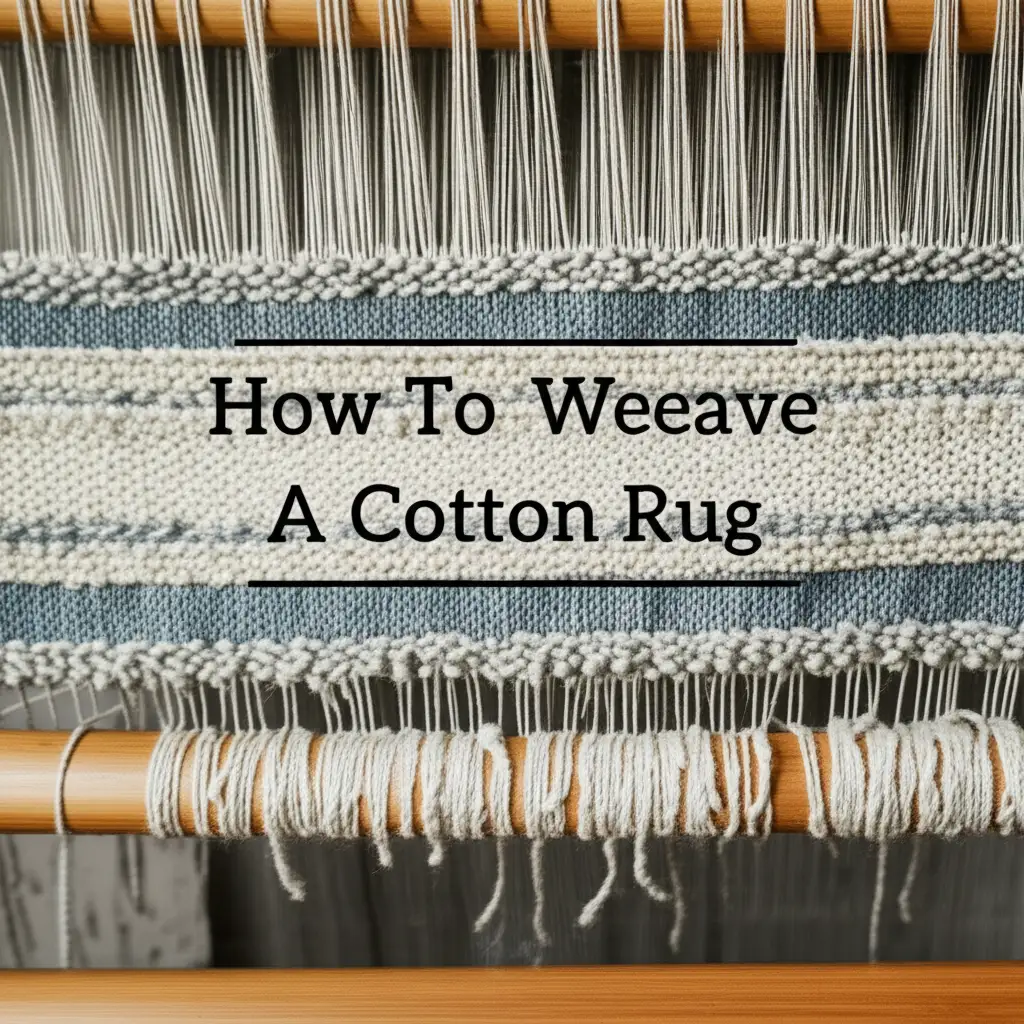· Tessa Winslow · Crafts · 18 min read
How To Weave A Cotton Rug

Mastering the Art of How To Weave A Cotton Rug
There is a special charm in creating items for your home with your own hands. Handmade pieces add unique warmth and character that store-bought items simply cannot match. If you are looking to bring a touch of personalized artistry to your living space, learning how to weave a cotton rug is a perfect project. Cotton rugs offer comfort, durability, and versatility. They fit well in many rooms.
This guide will walk you through each step of the process. You will learn about selecting materials, setting up your loom, and mastering basic weaving techniques. We will cover finishing touches and ongoing care for your new rug. By the end, you will have the confidence to weave a cotton rug that reflects your personal style. Let us begin this creative journey together.
Takeaway
- Choose suitable cotton yarn: Select durable and washable cotton for your rug.
- Prepare your loom correctly: Proper warping and tension are key for a successful weave.
- Master basic weaving patterns: Learn plain weave and other simple techniques.
- Finish your rug carefully: Secure ends and wash the rug for longevity.
- Maintain your woven rug: Regular cleaning helps your cotton rug last longer.
You can weave a cotton rug by preparing a loom, choosing strong cotton warp and weft yarns, and using basic weaving techniques. This process involves setting up the loom, interlacing weft threads over and under warp threads, and carefully finishing the rug. The result is a custom, durable home accent.
Understanding Cotton Rug Weaving Essentials
Cotton is an excellent choice for weaving rugs. It is soft, durable, and easy to clean. Cotton fibers absorb dye well, which means you can find a wide range of colors for your rug project. Its strength also makes it suitable for floor coverings. You want a rug that holds up to foot traffic.
Cotton yarn comes in various forms. For rugs, you will need strong, sturdy cotton. Look for cotton rope, cotton twine, or thick cotton yarns. Recycled cotton fabrics cut into strips also work well. These materials create a dense, firm rug surface. They stand up to everyday use.
Consider the rug’s purpose when choosing materials. A bath mat needs good absorbency. A living room rug needs high durability. Cotton meets both needs. You can layer different types of cotton for texture. This adds visual interest to your finished rug.
When selecting cotton, check its weight and thickness. Thicker cotton creates a faster project. It also makes a more substantial rug. Thinner cotton allows for more intricate patterns. Think about the overall feel you want for your rug.
Gathering Your Weaving Tools and Materials
Starting any weaving project requires the right equipment. Having everything ready before you begin saves time and frustration. For weaving a cotton rug, your main tool is a loom. There are different types of looms, and each has unique features.
Types of Looms:
- Frame Looms: These are simple and great for beginners. They are like a picture frame with pegs or notches. You stretch warp threads across these. They are portable and affordable.
- Rigid Heddle Looms: These are more advanced than frame looms but still beginner-friendly. A rigid heddle helps lift and lower warp threads. This speeds up the weaving process. They come in various sizes.
- Floor Looms: These are large, complex machines. They allow for fast production and intricate patterns. Floor looms are a significant investment. They require more space and learning.
For your first cotton rug, a rigid heddle loom or even a sturdy frame loom works well. You do not need a large loom to make a beautiful rug. You can weave smaller pieces and join them later. This makes large rugs possible on smaller looms.
Essential Materials:
- Warp Yarn: This is the yarn that runs lengthwise on the loom. It creates the foundation of your rug. Warp yarn needs to be very strong. It must withstand high tension. Cotton seine twine or carpet warp are common choices. Choose a color that complements your weft yarns.
- Weft Yarn: This yarn goes across the loom, over and under the warp threads. This is the yarn that forms the body and design of your rug. For cotton rugs, thick cotton yarn, cotton rope, or fabric strips work well. You can use old t-shirts or sheets cut into strips. This is a great way to recycle materials.
- Shuttle: This tool holds your weft yarn. It helps you pass the weft through the warp threads. Boat shuttles, stick shuttles, or rag shuttles are common. Choose one that fits your hand and loom size.
- Scissors: A good pair of sharp scissors is always needed. You will use them for cutting yarn and fabric strips.
- Tapestry Needle or Weaving Needle: These are useful for weaving in loose ends. They also help with finishing details.
- Measuring Tape: You need this for planning your rug size. It also helps you measure warp threads.
- Yarn Winder (Optional): This tool helps wind yarn neatly. It can make preparing your weft yarn easier.
- Beater or Weaving Comb: This tool helps push the weft threads down. This makes your weave dense and even. A sturdy fork can also work in a pinch.
Gathering these items before you start will ensure a smooth weaving experience. You will feel prepared and organized. This allows you to focus on the creative process.
Preparing Your Loom for Cotton Rug Weaving
Preparing your loom is a crucial first step in weaving a cotton rug. This process is called warping. It involves setting up the foundation threads. Proper warping ensures your rug will be even and durable. Take your time with this stage.
Calculating Warp Length and Width:
First, decide the size of your rug. Measure the length and width you want. Remember that weaving causes some “take-up” or shrinkage in both directions. Add about 10-20% to your desired length for shrinkage and loom waste. Loom waste is the length of warp you cannot weave. It stays on the loom.
For width, consider your loom’s maximum weaving width. Also, account for shrinkage. Cotton rugs can shrink 5-10% in width after washing. Plan for a slightly wider warp than your desired finished width. For example, if you want a 2x3 foot rug, you might need a warp that is 26 inches wide and 40 inches long. Knowing the correct dimensions helps when you measure for entryway rugs. You also need to know the correct dimensions if you want to determine what size rug for 12x12 room or what size rug for 11x11 room.
Warping the Loom:
- Measure Warp Threads: Cut your warp yarn to the calculated length. You will need many strands. The number depends on your rug’s desired width and the sett of your loom. Sett refers to the number of warp threads per inch. For a dense cotton rug, aim for 6-8 ends per inch (epi).
- Thread the Loom: This step varies by loom type.
- Frame Loom: Tie one end of each warp thread to a bottom peg. Pull it up to a top peg and tie it off. Repeat until your desired width is covered. Make sure the tension is consistent across all threads.
- Rigid Heddle Loom: This involves threading warp through the slots and holes of the rigid heddle. Then, you tie the warp ends to the back beam and the front beam. Follow your loom’s specific instructions for direct or indirect warping methods.
- Floor Loom: Warping a floor loom is a complex process. It involves a warping board or mill. Then you beam the warp onto the loom. This requires precision and often two people.
- Check Tension: After threading, check the tension of your warp threads. They should feel tight and even. If some threads are loose, adjust them. Uneven tension leads to an uneven rug. It also makes weaving difficult. You can use tensioning devices or simply adjust individual threads by hand.
- Prepare for Weaving: Once warped, your loom is ready. The warp threads form a strong, taut surface. This is the canvas for your cotton rug. You are now ready to begin weaving. This careful preparation sets the stage for a successful weaving project.
Mastering Basic Weaving Techniques for Rugs
Learning a few basic weaving techniques will help you create a beautiful cotton rug. These techniques are the building blocks of weaving. They involve how you interlace the weft threads with the warp threads. Weaving requires patience and practice.
Plain Weave (Tabby Weave):
The plain weave is the simplest and most common weave. It is perfect for beginners. In plain weave, the weft thread goes over one warp thread and then under the next. On the return pass, it goes under the first warp thread and over the next. This creates a strong, balanced fabric. Most rugs use plain weave for durability.
- Opening the Shed: On a rigid heddle loom, you raise or lower the heddle. This creates a space between alternating warp threads. This space is called the “shed.”
- Passing the Weft: Pass your shuttle, loaded with weft yarn, through the open shed. Make sure the weft goes all the way across.
- Beating Down: Use your beater or a weaving comb to push the weft thread firmly down. Push it against the previous row. This compacts the threads. It makes your rug dense and strong.
- Changing the Shed: Change the position of your heddle. This reverses the warp threads. It creates a new shed.
- Repeat: Pass the shuttle back through the new shed. Beat down. Continue this pattern.
Adding Texture and Color:
While plain weave is essential, you can add variety.
- Rya Knots: These knots add shaggy texture. They create a soft, pile surface. You tie short lengths of yarn around groups of warp threads. This forms a loop or fringe. Rya knots are common in traditional rugs.
- Twining: This technique involves using two weft threads. You twist them around each other between warp threads. It creates a strong, decorative edge or band. Twining can add stability to your rug.
- Color Blocks: Change your weft color to create stripes or blocks. Just tie off one color and tie on the next. You can also interlock colors for sharper lines.
- Strip Weaving: If using fabric strips as weft, you can mix and match. Combine different fabric patterns or colors. This makes a unique, eco-friendly rug.
Consistency is key when learning to weave. Try to keep your weft tension even. Beat down with consistent force. This helps create a rug with a uniform look and feel. Practice these techniques on a small sample first. This builds confidence before you start your main rug project.
Weaving Your Cotton Rug: Step-by-Step Process
Now that your loom is warped and you understand basic techniques, it is time to start weaving your cotton rug. This is where your vision comes to life. Focus on one step at a time.
- Start with a Header: Begin weaving with a few rows of plain weave. Use a scrap piece of yarn or the same weft yarn. This “header” helps stabilize the warp ends. It also provides a neat starting point. You will remove this later.
- Introduce Your Main Weft: Take your main weft yarn, loaded on your shuttle. Open the shed according to your loom type (e.g., raise the rigid heddle). Pass the shuttle through the shed. Make sure to leave a “bubble” or arc of yarn at the edge. Do not pull it too tight. This prevents your rug from narrowing.
- Beat Down the Weft: Use your beater or comb to push the weft thread down firmly. Push it against the header or the previous row of weaving. The goal is to make the weft tight and compact. This creates a dense rug.
- Change the Shed: Reverse the shed (e.g., lower the rigid heddle). The alternate warp threads will now be open.
- Pass the Shuttle Back: Pass your shuttle through the new shed in the opposite direction. Again, create a slight arc with the weft before beating. This maintains consistent width.
- Continue Weaving: Repeat these steps: open shed, pass shuttle, beat down, change shed. Maintain a consistent rhythm. Check your edges regularly. Make sure they are straight. If your edges start pulling in, you are pulling the weft too tight. Loosen your tension on the weft passes.
- Changing Weft Colors or Materials: When you want to change weft colors or introduce new fabric strips:
- Weave the current weft to the edge of your rug.
- Leave a tail of about 2-3 inches. Cut the yarn.
- Take your new weft yarn. Overlap the old and new tails for a few warp threads.
- Continue weaving. You will weave over the tails. This secures them. You can trim any excess later.
- Monitor Density: As you weave, periodically check the density of your rug. A well-beaten rug will be firm. You should not see much of the warp threads showing through. This creates a durable rug.
- Approaching the End: As you near your desired rug length, slow down. You will need enough warp remaining to secure the ends. Leave about 6-8 inches of un-woven warp. This allows for knotting or finishing.
Weaving is a meditative process. Enjoy the rhythm of the loom. Watch your rug grow with each pass of the shuttle. Every row adds to your handmade creation.
Finishing Your Handwoven Cotton Rug
Finishing your cotton rug properly ensures its longevity and a professional look. This is the final stage of the weaving process. It involves removing the rug from the loom and securing the warp ends.
- Remove from the Loom: Once you have woven to your desired length and left enough warp for finishing, it is time to cut your rug from the loom. Carefully cut the warp threads. Cut them evenly from the loom beams. Make sure to leave ample length on both ends. You need enough for knotting or fringing.
- Secure the Warp Ends: This is a crucial step to prevent your rug from unraveling.
- Fringing: The most common method for rugs is to create fringe. Take small groups of 2-4 warp threads. Tie them together in an overhand knot close to the woven edge. Pull the knots tight. Repeat across the entire width of the rug on both ends. This creates a durable fringe.
- Hemming (Alternative): If you do not want a fringe, you can hem the ends. After removing from the loom, you can machine-stitch or hand-stitch across the woven edge. This secures the warp loops. Then, fold the raw warp ends under and stitch them down. This creates a clean, folded edge.
- Weaving In Ends: Some people prefer to weave the warp tails back into the rug. Use a tapestry needle to pull the warp tails through the woven fabric. This hides them completely. This method makes a seamless look. It is often used when a fringe is not desired.
- Trim Excess: After securing the ends, trim any excess warp yarn. If you created a fringe, trim it to your desired length. Make sure the fringe is even.
- Initial Washing: Cotton rugs benefit greatly from an initial wash. This helps the fibers full up and compact. It also helps set the weave.
- Hand Washing: For smaller rugs or those with delicate techniques, hand washing is best. Use cool water and a mild detergent. Gently agitate the rug. Rinse thoroughly until the water runs clear. You can learn more about how to clean a rug by hand. This gentle method protects the fibers.
- Machine Washing: Many cotton rugs can be machine washed. Use a gentle cycle with cold water. Use a mild detergent. Avoid using harsh chemicals or bleach.
- Drying: After washing, gently squeeze out excess water. Do not twist or wring the rug. Lay the rug flat to dry on a clean surface. You can also hang it over a clothesline. Ensure it is fully supported to prevent stretching or distortion. Allow it to air dry completely. This may take a day or two.
Finishing your rug adds to its appeal and ensures it lasts for years. You have transformed yarn into a functional piece of art.
Caring for Your New Cotton Rug
Caring for your handwoven cotton rug keeps it looking fresh and extends its life. Cotton is a robust fiber, but proper maintenance makes a big difference. Regular cleaning is a simple way to preserve its beauty.
Regular Maintenance:
- Vacuuming: Vacuum your cotton rug regularly. Use a vacuum cleaner with a brush attachment or suction-only setting. Be gentle, especially if your rug has a fringe or intricate weave. Avoid settings that are too harsh. Frequent vacuuming removes dirt and dust before it settles deep into the fibers.
- Shaking Out: For smaller rugs, take them outside and give them a good shake. This helps remove loose dirt and debris. It is a quick way to refresh your rug.
- Spot Cleaning: Accidents happen. If you spill something, clean it immediately.
- Blot, do not rub, the spill with a clean cloth.
- Use a mild soap and water solution for stubborn spots.
- Dab the area gently.
- Rinse with a clean, damp cloth.
- Pat dry completely.
Deep Cleaning Your Cotton Rug:
From time to time, your cotton rug may need a deeper clean.
- Machine Washing: Many cotton rugs are machine washable. Check your specific yarn type. Use a large-capacity machine if possible. Wash on a gentle cycle with cold water and mild detergent. This helps prevent shrinkage and fading. Always let it air dry.
- Hand Washing: For very delicate or large rugs, hand washing is a good option. Fill a bathtub with cool water and mild soap. Submerge the rug and gently agitate. Rinse thoroughly. This method is effective for handwoven items, similar to how one might clean a handwoven wool rug. For general handwoven rugs, learning how to clean a rug by hand is very useful. This gentle care helps keep your rug in good shape.
Important Tips for Longevity:
- Use a Rug Pad: A non-slip rug pad offers many benefits. It prevents the rug from slipping. This keeps you safe. It also protects your floor. A rug pad cushions the rug. This reduces wear and tear on the fibers. It extends the rug’s life.
- Rotate Your Rug: If your rug is in a high-traffic area, rotate it every few months. This ensures even wear across the surface. It prevents one area from wearing out faster than others.
- Protect from Sunlight: Direct sunlight can fade the colors of your cotton rug over time. If possible, place your rug where it gets less direct sun. Or, use blinds or curtains to filter sunlight during peak hours.
- Avoid Harsh Chemicals: Do not use strong chemical cleaners or bleach on your cotton rug. These can damage the fibers and cause discoloration. Stick to mild, pH-neutral detergents.
By following these simple care tips, your handwoven cotton rug will remain a beautiful and functional piece in your home for many years. You put effort into weaving it, so caring for it helps preserve your hard work.
FAQ Section
Q1: How long does it take to weave a cotton rug? A1: The time it takes to weave a cotton rug depends on several factors. These include the rug’s size, your loom type, and your weaving speed. A small bath mat on a rigid heddle loom might take a few days of weaving time. A larger area rug could take several weeks or even months of dedicated work. Practice increases your speed.
Q2: Can a complete beginner weave a cotton rug? A2: Yes, a complete beginner can definitely weave a cotton rug. Starting with a simple frame loom or a rigid heddle loom is recommended. Focus on basic plain weave. Choose a smaller project for your first rug. There are many online tutorials and resources available to guide you. It is a rewarding hobby to learn.
Q3: What is the best type of cotton yarn for rug weaving? A3: The best type of cotton yarn for rug weaving is sturdy and durable. Look for cotton carpet warp for the lengthwise threads. For the weft, choose thick cotton yarns, cotton rope, or fabric strips. These materials create a dense, long-lasting rug. Recycled cotton is also an excellent, eco-friendly option.
Q4: How do I prevent my rug from shrinking unevenly after washing? A4: To prevent uneven shrinkage, beat your weft threads down consistently during weaving. This creates an even density. When washing, use cool or cold water and a gentle cycle. Air dry the rug flat or hang it with good support. Avoid high heat from dryers, which can cause significant and uneven shrinkage.
Q5: What are common mistakes beginners make when weaving rugs? A5: Common mistakes include inconsistent weft tension, which leads to narrow or “waisted” rugs. Another mistake is uneven beating, causing varying density. Not securing warp ends properly can lead to unraveling. Also, sometimes beginners do not plan enough loom waste. This makes finishing difficult. Patience and practice help avoid these issues.
Q6: What is the ideal loom for weaving a cotton rug? A6: The ideal loom depends on your experience and desired rug size. For beginners, a rigid heddle loom is versatile and user-friendly for small to medium rugs. If you want larger, complex rugs, a floor loom is better. For very small, simple projects, a frame loom can even work. Choose a loom that fits your space and budget.
Conclusion
Learning how to weave a cotton rug is a rewarding journey. You transform simple strands of cotton into a beautiful, functional piece for your home. We have covered everything from gathering your essential tools to preparing your loom. You also learned basic weaving techniques and how to properly finish your new creation. The process is a blend of art and skill.
Remember to choose strong cotton for durability. Take your time with warping the loom to ensure even tension. Practice plain weave until you feel comfortable. Your finished rug will be a testament to your creativity and effort. It adds a unique, handmade touch to any room. Now that you know how to weave a cotton rug, why not start your first project? Embrace the joy of creating something truly special. Begin your weaving adventure today!





